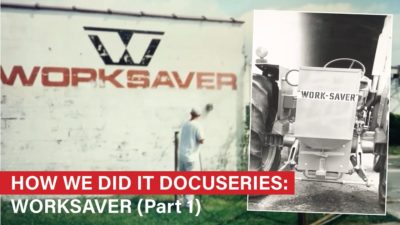Reputation management is one of the greatest opportunities for dealers to improve the quality of the operation and the customer experience, as well as their brand image. You don’t have to Google too many OPE dealers to find one with a sub 4-star average and/or fewer than 10 reviews over the last 10 years.
Within a few miles of that store, there might be a restaurant, car dealership, powersports dealership, and HVAC company with 100+ reviews, 4.5 star average or better, several of which were posted in the last few weeks. By comparison, this can leave the impression that there isn’t much going on at that OPE dealership, and perhaps that the average customer experience is very poor. The reality is that most of the time, that couldn’t be further from the truth!
This is all too common of major ag and OPE dealers, even in the Dallas-Fort Worth metroplex. There are stores that are easily $10-20 million in revenue, and have easily 10,000-20,000 transactions per year. Shouldn’t a business that large have thousands of reviews online, good and bad? Many of the restaurants that have dozens or hundreds of reviews are often $1-2 million operations, and they don’t even know who their customers are, most of the time.
My family’s dealership was a prime example. We had been in business for 9 years and had sold tens of millions of dollars in equipment to thousands of customers, and had maybe 10 reviews online, with an average rating of under 3 stars. Frankly, we deserved a few of those bad reviews, but some were just untrue. In every case, we tried to salvage the situation, but weren’t always given the chance.
I wondered how much it mattered until one Saturday, a lady didn’t show up to purchase the $32,000 tractor she assured me she was buying. I called and couldn’t reach her. Monday rolled around, and I was finally able to get her on the phone. Her husband had apparently gone online to check us out, saw some bad reviews, and decided not to chance it on us, and went to a major ag dealer up the road and made their purchase.
When I tried to explain that the reviews were old and most of them were people that wouldn't let us help them, she informed me that if just one of those reviews was true, she would never do business with us. That was a hard lesson on the importance of reputation management, and that was in 2013. Reviews and social proof have become significantly more important in retail, 7 years later. Had she and her husband seen a more reasonable representation of the customer experience, such as 100-200 reviews, they probably wouldn't have drilled down into the reviews to find the handful of unflattering reviews.
Getting Started with Reputation Management Strategies
After the debacle with the lost tractor sale over bad reviews, we focused on turning our online presence into a more accurate portrayal of the customer experience. We eventually grew our online presence to over 3,000 reviews, with 4.5 stars on average, and we did that by selecting a survey tool that texted and emailed the customer shortly after they completed a transaction, whether it was a new machine, parts, or service.
It was an extremely short survey, which is important. If a survey is more than 2-3 steps, people don't complete them. The survey was a single question: "How was your experience with us?" They rated us, and if the rating was poor, they were immediately given a place to leave comments, and once they tapped "submit," they were done.
Those that rated us well were immediately taken to a page thanking them for the good feedback and asking them to leave us a review, giving them 1-2 places (Facebook and Google) to leave that review. A high percentage of the time, they clicked through and left the review. In peak season, we were getting 2-3 reviews per day! The key is that this feedback process was three short steps, including the original email or text message, and they were done. It was short and mobile-friendly, so it was easy for people to give feedback, good or bad.
In the scenario where they left a poor rating, with or without comments, I got an immediate email notification, which allowed me to address the problem quickly. Many times, the poor rating was due to a simple problem, like a missing owner's manual or they didn't get a spare key with their mower. We addressed the problem and they were happy again. By offering them an offline place to address a problem, this drastically reduced our 1 and 2-star reviews!
Most customers don't want confrontation, and they may not tell you that they didn't get their spare key or owner's manual. They just may never return. An automated feedback tool can salvage these customers while preserving and building your online reputation.
Measuring the Pay-Off
As with a lot of marketing activity, it's not always easy to translate reputation management into business activity. However, Fred Reichheld of Bain & Co. developed a system to solve that problem: the Net Promoter System. Most of the business world runs on this program, so we followed suit in my dealership. The Net Promoter System calculates the difference between the percentage of customers who said they were highly likely to refer friends and family to us (Promoters) and the percentage of customers who said they were highly unlikely to do so (Detractors).
Uncovering Your Dealership’s Star Performers
The other powerful take-away from an automated feedback loop system is that patterns quickly emerge. Your team's MVPs instantly become apparent, as well as the “Negative Nancys.”
You learn quickly who is terrible at returning phone calls and who forgets to give a customer their spare key. If you're not in tune with how the shop is treating customers, you can’t see if there's a pattern of customers being promised repair estimates, but not receiving them. All sorts of opportunities to improve processes and customer service arise from proverbially taking the temperature right after the transaction happens.
Promoters promote your business without you having to incentivize them to do so. They love your brand, your team, and perhaps what you stand for as a company. Detractors, on the other hand, not only don't return to purchase again, but also actively discourage others from doing business with you. Detractors are much more powerful and motivated than promoters, especially in the day and age of social media. A company looking to grow does so by creating a happy, loyal customer base.
A way to tie customer sentiment to business effort would be to look at NPS side-by-side with your monthly, quarterly, and annual financials. If you had a blowout month, what did that look like from the customers' perspective? Did NPS remain high? Often times, when we are spread thin, the customer experience suffers.
However, if a team is laser focused on the customer, is returning phone calls, fulfilling promises, and so forth, the sales dollars rise with NPS. Happy customers refer to their friends, neighbors, colleagues and family members, and we all know that referrals and word of mouth marketing is the cheapest and most effective form of marketing. An upward trend in NPS frequently correlates to an upward trend in profit.
Tools to Get Started
There are hundreds of survey tools on the market. We developed an integration between one such tool and our dealership management system, which is the best way to automate the process. Your point of sale should trigger a survey immediately or almost immediately after the transaction. Otherwise, it will take a few minutes per day or week to export the transactions and upload into a survey tool of your choice.
Time is of the essence when surveying, so you don't want to wait too long to measure the customer experience, especially if there is an issue that could lead them to leaving a bad review and complaining to the OEM about you.
To take things to the next level, once you are comfortable with the feedback loop in, and are addressing process break-downs, a powerful marketing strategy is to create segments of your high NPS customers, the ones who said they are highly likely to refer people to your business, and market to them. These customers are your VIPs, and are most likely to open their wallet again with you. Target marketing and even referral campaigns with incentives to refer new customers to you is massive and is proven to give better results than just blasting promotions to customers, regardless of where they live and what they think of your business.
Another powerful strategy is to leverage Merchant Reviews sites that many e-commerce brands are using to supplement your Google reviews, such as TrustPilot, ShopperApproved, SiteJabber, and ResellerRatings. By building your reputation on these sites, you make your star rating visible on your Google Ads, something almost nobody in the OPE space is doing. This is an eye-catcher, and makes your ad stand out from the sea of plain text that customers see on the search page.
Your customers love you. Your next customers — the ones that are on Google researching you as you read this — need to know that. Surveys are for you to take care of customers now, and to fix your processes. Online reviews are for your future customers. Take ownership of your reputation and watch your business grow!
Dealer Takeaways
- Surveys are for you to take care of customers now, and to fix your processes. Online reviews are for your future customers.
- Generate more online reviews by leveraging a survey tool (mobile-friendly is a must) that makes it easy for customers to leave reviews and comments.
- Measure your Net Promoter Score or a similar rating system and study those numbers alongside financials.






Post a comment
Report Abusive Comment